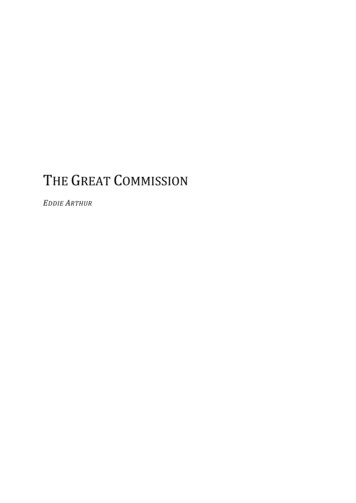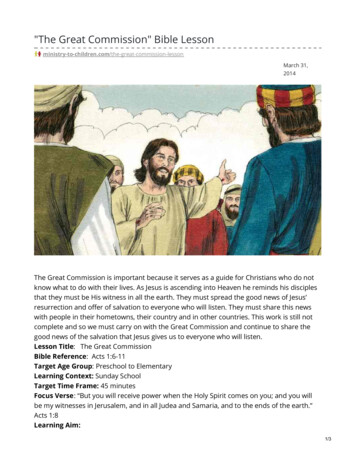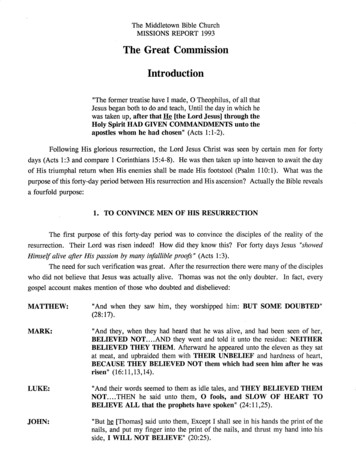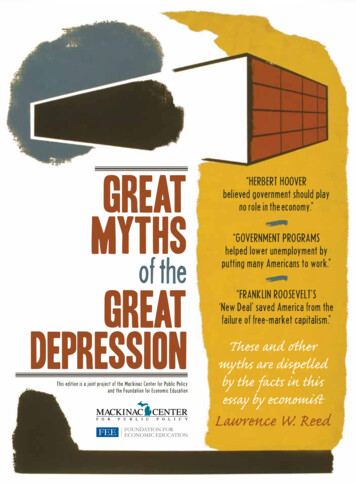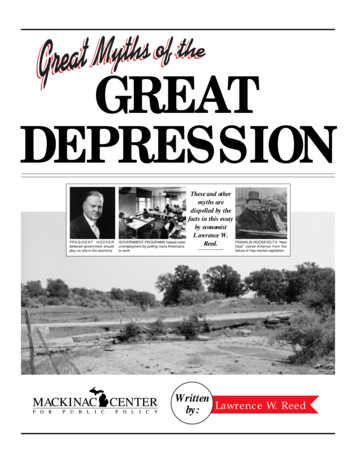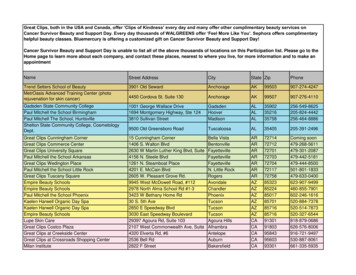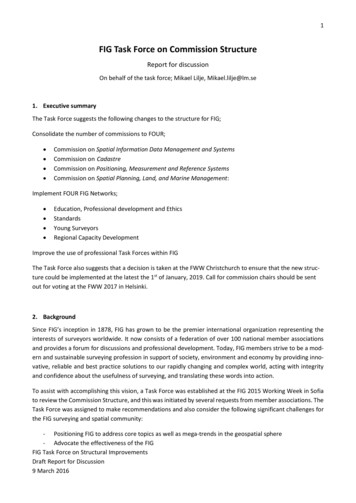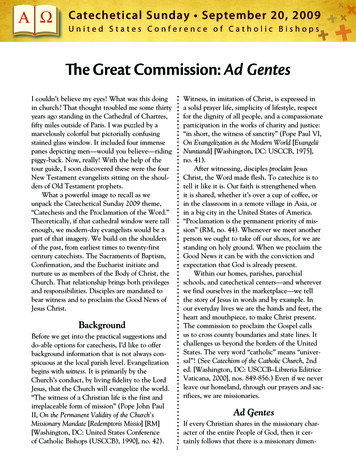
Transcription
The Great Commission: Ad GentesWitness, in imitation of Christ, is expressed ina solid prayer life, simplicity of lifestyle, respectfor the dignity of all people, and a compassionateparticipation in the works of charity and justice:“in short, the witness of sanctity” (Pope Paul VI,On Evangelization in the Modern World [EvangeliiNuntiandi] [Washington, DC: USCCB, 1975],no. 41).After witnessing, disciples proclaim JesusChrist, the Word made flesh. To catechize is totell it like it is. Our faith is strengthened whenit is shared, whether it’s over a cup of coffee, orin the classroom in a remote village in Asia, orin a big city in the United States of America.“Proclamation is the permanent priority of mission” (RM, no. 44). Whenever we meet anotherperson we ought to take off our shoes, for we arestanding on holy ground. When we proclaim theGood News it can be with the conviction andexpectation that God is already present.Within our homes, parishes, parochialschools, and catechetical centers—and whereverwe find ourselves in the marketplace—we tellthe story of Jesus in words and by example. Inour everyday lives we are the hands and feet, theheart and mouthpiece, to make Christ present.The commission to proclaim the Gospel callsus to cross county boundaries and state lines. Itchallenges us beyond the borders of the UnitedStates. The very word “catholic” means “universal”! (See Catechism of the Catholic Church, 2nded. [Washington, DC: USCCB–Libreria EditriceVaticana, 2000], nos. 849-856.) Even if we neverleave our homeland, through our prayers and sacrifices, we are missionaries.I couldn’t believe my eyes! What was this doingin church? That thought troubled me some thirtyyears ago standing in the Cathedral of Chartres,fifty miles outside of Paris. I was puzzled by amarvelously colorful but pictorially confusingstained glass window. It included four immensepanes depicting men—would you believe—ridingpiggy-back. Now, really! With the help of thetour guide, I soon discovered these were the fourNew Testament evangelists sitting on the shoulders of Old Testament prophets.What a powerful image to recall as weunpack the Catechetical Sunday 2009 theme,“Catechesis and the Proclamation of the Word.”Theoretically, if that cathedral window were tallenough, we modern-day evangelists would be apart of that imagery. We build on the shouldersof the past, from earliest times to twenty-firstcentury catechists. The Sacraments of Baptism,Confirmation, and the Eucharist initiate andnurture us as members of the Body of Christ, theChurch. That relationship brings both privilegesand responsibilities. Disciples are mandated tobear witness and to proclaim the Good News ofJesus Christ.BackgroundBefore we get into the practical suggestions anddo-able options for catechesis, I’d like to offerbackground information that is not always conspicuous at the local parish level. Evangelizationbegins with witness. It is primarily by theChurch’s conduct, by living fidelity to the LordJesus, that the Church will evangelize the world.“The witness of a Christian life is the first andirreplaceable form of mission” (Pope John PaulII, On the Permanent Validity of the Church’sMissionary Mandate [Redemptoris Missio] [RM][Washington, DC: United States Conferenceof Catholic Bishops (USCCB), 1990], no. 42).Ad Gentes1If every Christian shares in the missionary character of the entire People of God, then it certainly follows that there is a missionary dimen-
sion to every vocation. “The Church on earthis by its very nature missionary since, accordingto the plan of the Father, it has its origin inthe mission of the Son and the Holy Spirit”(Second Vatican Council, Decree on the Church’sMissionary Activity [Ad Gentes] [AG], no. 2, inVatican Council II: Volume 1: The Conciliar andPost Conciliar Documents, new rev. ed., ed. AustinFlannery [Northport, NY: Costello Publishing,1996]). I suggest a rather simple analysis of thismissionary dimension of the Christian life. In theChurch, both “stationary” missionaries and “foreign” missionaries are commissioned to continuethe mission of Jesus. At the end of Mass the celebrant announces, “Go, the Mass is ended.” Inboth small-town America and the grasslands ofAfrica we are sent off from every Mass as “missionaries of the Eucharist.” Fed by Word andSacrament, we nurture one another. The challenge that the Gospels present tous is to move outside our spiritual comfort zone.Jesus’ whole life and teaching were directedtoward announcing the Kingdom of God andbringing it about. These actions continue to befulfilled today whenever disciples open themselves to the love of the Father, manifested andgiven by Jesus through the Holy Spirit. Yes,earthly kingdoms are limited to a particular people or place. But in the Kingdom of God, Jesus,the Word made flesh, shares in God’s dominionover the whole world. The Kingdom is not fulfilled until it embraces the entire human race:“You will receive power when the holy Spiritcomes upon you, and you will be my witnesses. . . to the ends of the earth” (Acts 1:8). Throughprayer, study, service, and sacrifice we canembrace global Kingdom ministry, without everleaving home.In order to witness, the Church needs witnesses. To engage in missionary activity, theChurch needs missionaries. The great commission is clear. What to do? Go, make disciples.How to do it? Baptizing and teaching. In whosename? In the name of the Trinity. “Go, therefore, and make disciples of all nations, baptizingthem in the name of the Father, and of the Son,and of the holy Spirit, teaching them to observeall that I have commanded you” (Mt 28:19).The Latin expression “ad gentes,” literally“to the nations,” refers to the Church’s mission to peoples everywhere, with particularattention to those who have not yet beenevangelized. That expression provided theLatin title for the Second Vatican Council’sDecree on the Church’s Missionary Activity.If we get up close and personal withScripture, we can make an interesting observation. Jesus gave the Church a “mission ad gentes.”We can identify “ad gentes” from varying pointsof view, relating to the pastoral purpose of eachGospel and perhaps even the personality of eachevangelist. Consider the following: In St. Mark’s Gospel, we learn of tough timesfor disciples, but still the Gospel must bebrought to all nations (Mk 13:9-10).Behind bolted doors, St. John notes, the risenJesus appears and offers peace: “as the Fatherhas sent me, so I send you” (Jn 20:21).Stories AboundIn Matthew’s Gospel, Jesus sends the Churchto baptize and to make disciples of all nations(Mt 28:19).Filled with the Holy Spirit, as St. Lukerecords in Acts, we are to bear witness “to theends of the earth” (Acts 1:8). Really, the mission “ad gentes” of the Church is the principletheme in Acts. Every event in the narrative isrelated to the Church’s universal mission.Here are several stories of ways in whichChristians have lived out the call to carry on theChurch’s missionary activity. These stories comefrom materials distributed by Pontifical MissionSocieties, USA, for World Mission Sunday. 2One local priest of Bluefields, Nicaragua,travels by boat to visit about ten small
ourselves. The Gospel also speaks to societyitself, with its values, goals and systems. . . .Sometimes this means that, as believers, wemust confront the world as did the prophets ofold, pointing out the claims of God to societiesthat are blind to God” (USCCB, Go and MakeDisciples: A National Plan and Strategy for CatholicEvangelization in the United States, 10th anniversary ed. [Washington, DC: USCCB, 2002], no.17). In bringing the Gospel to the nations of theworld, the foreign missionary meets different cultures and embarks on the long process of inculturation. (Teaching high school students todaymay give one a similar feeling.) Inculturationrequires both the transformation of authentic cultural values through integration in Christianity,and the insertion of Christ into the values ofvarious cultures. The Church enriches a culturein which she makes the Gospel incarnate. Ah!But the Church herself is enriched by diverse cultures in areas like evangelization, worship, theology, justice, and charity. Throughout the processof inculturation, missionaries and all catechistsare to be guided by two principles: compatibilitywith the Gospel and communion with the universal Church.Together with the pope, bishops are responsible for the mission of the Church ad gentes: “Allbishops . . . are consecrated not for one diocesealone, but for the salvation of the whole world”(AG, no. 38). Under the direction of the HolyFather, the task of directing and coordinatingthroughout the world the ministry of evangelization and of missionary cooperation is entrustedto the Congregation for the Evangelization ofPeoples, in the Vatican.The leading role in fostering a global missionary spirit among the People of God belongsto four societies of the universal Church: theSociety for the Propagation of the Faith, theHoly Childhood Association, the Society ofSt. Peter Apostle, and the Missionary Union ofPriests and Religious. These are the PontificalMission Societies, whose mobilizing motto is“all of us committed to the worldwide mission ofJesus.” To become more familiar with the amazing outreach of each society, see the Web sitecommunities along Pearl Lagoon. He says hisvocation was inspired by missionaries he metwhile growing up. “Now I am a missionarymyself,” he says, “bringing Christ to others inmy own country.” After those visits, the parish catechists continue to teach the peopleabout the faith.“We must be the Lord’s voice to the poor,telling of his great love,” says Sr. Christine.Sr. Christine and others in her religious congregation manage HIV/AIDS programs andcare for orphans in Zambia.Fr. Pierre Kitengiie was called out of hisnative Africa and sent as a missionary toMongolia. “My presence brings them to askquestions.” He continues, “These questionscall me to tell them about the faith, aboutJesus. I introduce the Gospel.” In Easter 2007,seventy people were baptized in his mission,bringing the total number of Catholic converts in Mongolia to 345.“The youngsters here are most grateful forthe missionary children of the United States,”wrote Bishop Stuart O’Connell of Rarotongaon the Cook Islands. “Support offered throughthe Holy Childhood Association keeps ourreligious education program running.”A woman confined to her home in thePhilippines because of illness tells how themissionaries encouraged her to offer herprayers and sufferings for the missions. Theirmessage changed her life. “I felt useless, butthe missionaries brought me hope. I who neverthought of going out of my little village havereached other continents through prayer.”Catechists in Louisiana say their work withConfirmation classes help them to growspiritually in their own lives. When breakingopen God’s Word with the youth or while sitting with them in the presence of the BlessedSacrament, catechists say, they are challengedto deepen their own faith commitments.Evangelization of Peoples“Faith is not something that only happens toeach of us individually or privately, within3
www.onefamilyinmission.org. As part of this “onefamily in mission,” all are urged to foster the missionary zeal that is so central to the Christianlife. The Church’s universal mission is aboutforming and informing through catechesis, promoting vocations “ad gentes,” and encouragingcooperation in the work of evangelization (seeAG, no. 41).Resources and ActivitiesThe following is a practical checklist of thingsyou can do to increase personal awareness andsupport catechetical encounters: Reflect on the theme of mission in theScriptures and church documents. Whatcomforts, challenges, or confuses you? Praywith that.Subscribe to Mission Magazine. It is a free publication. The magazine is also available in bulkwith a study/discussion guide for junior andsenior high school students, RCIA programs,or other parish organizations. This sixteenpage magazine, published three times a year,carries up-to-date photos and succinct articlesof general interest. For a subscription, call(800) 432-2222 or e-mail mission@propfaith.org. Read other mission magazines as well. Aresuch magazines available on the parish pamphlet rack or in the school library? Use missionmagazines to supplement catechetical textsand to teach “Church-in-mission.”Contact the local diocesan office of thePontifical Mission Societies. What can theparish plug into? World Mission Sunday isthe second-to-last Sunday of each October.Brainstorm about what can be done to makeWorld Mission Sunday a more vibrant liturgical celebration in your parish. Perhaps invitea returned missionary to speak in the pulpitor classroom. Use world artifacts to recall ourcross-cultural connectedness. Pray the intercessions in several languages. (Similar ideaswork well for the solemnities of Christ theKing and Pentecost.)During Sunday liturgical celebrations, regularly include an intention for world missions 4as a consciousness-raiser. Pope Benedict XVIpublishes monthly mission intentions thatcan be included in the parish bulletin or usedin other creative ways. Remember to prayfor missionary vocations and the missionsbefore classes or parish meetings. Make theprayer more personal by getting from yourlocal mission office names of people in your(arch)diocese serving outside the UnitedStates. Consider praying for a particular partof the world by country or continent. Usethe Internet to search for a few facts regarding mission areas’ population, food and waterissues, religion, education, and health concerns to inform prayer intentions.Visit www.worldmissionrosary.org to learnabout the mission rosary initiated byArchbishop Fulton J. Sheen in 1951. Plan aparish or school event with a “living worldmission rosary.” Promote the connectionbetween continents and colors of bead (yellow for Asia, white for Europe, red for theAmericas, and so on). There are endless possibilities for promoting awareness, with plentyof good information on the Web site. HailMary decades could be represented by coloredT-shirts or wide ribbons, or in some otherway. Use a bulletin board or a “page fence”(a chain-link fence with plastic cups wedgedinto the holes) for a public display.Talk about the meaning of sacrifice.Encourage the People of God to “offer up”something in the name of Jesus for thestrength and courage of foreign missionariesand those they serve.Enduring physical suffering, doing difficultthings without complaining, and givingmonetary offerings (perhaps through thesacrifice of a candy bar or one less musicCD) are all forms of sacrifice we can offer inunion with the crucified Christ in the spiritof the Gospel. Discuss what financial giftscan accomplish to promote evangelizationand human dignity. Given as a class or a parish, the group’s offering of 5 can support aseminarian for a day, while 25 can help feeda lay catechist for a week, 75 can provide
Bibles for religious instruction, and 100 canhelp a mission church make repairs.Fast-food containers can make great propsfor reminding young missionaries that forgoing a sundae could help buy medicine for asick child.Are you familiar with missionary saints? Dosome research about the holy persons whofirst brought the faith to your (arch)diocese.Become familiar with their joys and struggles.Realize that only slightly more than a hundred years ago, the United States was considered mission-dependent—that is, in needof financial support from the Society for thePropagation of the Faith.Visit the Web site www.onefamilyinmission.org to learn specifically about the HolyChildhood Association (HCA). Explorethe different sections, such as “What’s NewNow?” or “HCA for Educators/Catechists.”You will find downloadable, print-readymaterials that you can use for catechesisabout missions. Print out the calendar withsuggestions for mission education: storiesabout missionary saints, prayers, facts, and“fund”-raising ideas. Let the young missionaries go directly to www.hcakids.org for creative,kid-friendly mission animation and cross-cultural appreciation. Become an HCA memberand get the bright and informative newsletter, It’s Our World. Little ones will delightin Polly Parrot, the HCA mascot. They caneven write to Polly or participate in one ofthe contests.Use the Internet to research the phrase“10/40 window.” This term was coined in1990 by the Christian missionary strategistLuis Bush to refer to those regions in theeastern hemisphere located between 10 and40 degrees north of the equator. Look at themaps turned up by the Internet search, andbe astounded by the data available. Did youknow that more than 3,000 groups of peopleare still waiting for the Bible to be translatedinto their language?Visit other Web sites of interest, includingthe following:— www.usccb.org/wm. Best mission practicesfrom the USCCB’s Committee on WorldMissions, for dioceses, parishes, classrooms,etc.— www.iamamissionary.org. Sixty-secondstories that are lessons from the missions,found in the “Publications and Media” section of the Pontifical Mission Societies’Web site.— www.themissionreport.org. A blog withreflections on missionary journeys.— www.youtube.com/pmsusa. Video footagefrom the missions.In addition to these Web sites, various Web sitesof religious congregations can offer a treasuretrove of mission information. For example, boththe Columbans (www.columban.org) and theMaryknoll Fathers (www.maryknoll.org) haveonline adult faith formation materials for missioneducation, as well as exciting kid-sized projects.The prophets foretold the coming of theMessiah. The evangelists recorded the public lifeand ministry of Jesus and, through the power ofthe Holy Spirit, passed on to us his mission. “Thepresent century thirsts for authenticity. . . . Doyou really believe what you are proclaiming? Doyou live what you believe? Do you really preachwhat you live?” (EN, no. 76). May our ministryof catechesis and evangelization be a mosaic ofstained glass shining brightly “ad gentes.”Article by Sr. Judith Gomila, MSCExcerpts from Vatican Council II: The Conciliar and Post ConciliarDocuments edited by Austin Flannery, OP, copyright 1975,Costello Publishing Company, Inc., Northport, NY, are used withpermission of the publisher, all rights reserved. No part of theseexcerpts may be reproduced, stored in a retrieval system, or transmitted in any form or by any means—electronic, mechanical,photocopying, recording, or otherwise—without express writtenpermission of Costello Publishing Company.Copyright 2009, United States Conference of CatholicBishops, Washington, D.C. All rights reserved. Permission ishereby granted to duplicate this work without adaptation for noncommercial use.5
The commission to proclaim the Gospel calls us to cross county boundaries and state lines. It challenges us beyond the borders of the United States. The very word "catholic" means "univer-sal"! (See Catechism of the Catholic Church, 2nd ed. [Washington, DC: USCCB-Libreria Editrice Vaticana, 2000], nos. 849-856.) Even if we never



